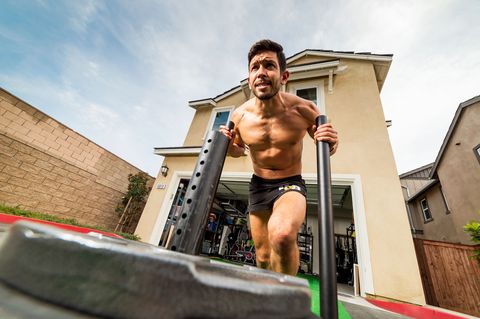Holden Comeau, a former pro triathlete, is working hard in third place in the Zwift National Championship race, with about 600 meters to go. He sees the two cyclists ahead of him start to pull away but patiently waits until the 100-meter mark to make his move. When it’s in sight, he stands up to hammer and deliver max sprinting power—1,353 watts—into his pedals. It’s just enough to edge past the two leaders—and maintain his lead against the 750 other competitors—to win the race and make him Zwift’s number-one-ranked rider at the time, in 2019. Comeau sits up, pumps his fists, and screams with joy.
I’ve never screamed so loud,” recalls the 42-year-old cofounder of a digital analytics company. Moments after his win, he got off his bike; turned off his fans, air conditioners, and TV; and headed upstairs, wondering how much of all that celebrating the neighbors heard.
This is racing on Zwift, a virtual-riding and -racing platform for cyclists and runners that’s seen a threefold increase in uploaded rides in the past year, and maybe a few-fold increase in shouting neighbors. It’s e-sports meets real racing. Your legs power your avatar through a course that looks fresh out of a digital game, complete with weather and nature, and you can message other riders as you go.

Before the pandemic, the peak number of people racing on Zwift or just riding at the same time on a given day was about 16,000. It’s past 35,000 now. (And in the virtual world, that’s all good: A giant pack of lightning-fast cyclists aren’t going to take anybody—or one another—out.) When workouts and everything else moved indoors last spring, the IRL races everyone had been training for vanished. Luckily, technology, race directors, and the competitive spirit stepped in to fill that void.
For instance, New York Road Runners (NYRR) put on 18 virtual races in 2020—including the New York City Marathon—and has no plans to abandon virtual racing in 2021. USA Triathlon sanctioned roughly 100 virtual events in 2020—up from essentially zero in 2019. And back in 2019, many athletes doing Spartan obstacle races traveled to events every weekend. In 2020, some raced from home almost every day.
Motivation, fitness, travel savings and other gifts from virtual races
Even as in-person races start to pop back up here and there—albeit in altered formats—organizers are keeping virtuals in the mix. That means that this year, there’s no need to let a global pandemic put your bucket-list fitness goals on hold.
Virtual races might even tap you into a community that motivates you. NYRR, for example, hosted a few as early as 2018 to expand access for nonlocal athletes. That means someone from Roanoke and someone from Rome could run the same race and both appear on the finisher chart. They can even “do” the race together on FaceTime or Zoom. Virtual races are also staying on athletes’ rosters so they can save on travel costs, compete frequently, and test strategies that let them crush it when their desired events come back in person.
Spartan race competitor Tim Frame, 55, hit a fitness peak thanks to virtuals. He’d been a regular at in-person events, traveling on weekends to meet and compete. “I was in this mindset of ‘Let’s party with the crowd and do a fun run,’ ” he says. On his own, however, he tuned into his performance metrics and found motivation there. The fact that he could do a virtual race from home nearly every day—and it earned him points on a leaderboard—drove him to complete 95 Spartan races since COVID-19 hit. “It changed how I competed against myself—I’m in the best shape of my life.”

Virtuals are more fun than you expect
It can be a drag that you won’t get the crowds or the cheers or a high five from your family at the finish line, but race organizers are making an effort to give virtual events energy by gamifying the experience or by using tech like apps that let you see where others are on a course. In the Wings for Life World Run, for instance, you run as far as you can until a catcher car reaches you. Racers around the world all start at the same time—for Red Bull ultrarunner Dylan Bowman, that was 4:00 a.m.—and receive periodic alerts. “There was one voice that was encouraging, telling you when you’d hit a certain distance. And there were updates from the catcher car that were still good-natured but a little more ominous. It had character and made it easy to stay motivated. I was impressed at how technically advanced it was.”

How to make a virtual race more “real”
If you’re picky about the races you do (see our starter list of some fun ones below), you’ll be inspired to train and do your best. Trust us. We’ve done it the meh way and the “I’d do it again” way. Here’s how to make a virtual race experience more fun.
Find a legit leaderboard
Races based on honesty-system reporting always feel anticlimactic. Instead, choose an event with an interface that uploads stats from your tracker (Garmin, Strava, Fitbit, etc.) and then declares a winner.
Check out the swag
If a medal or a T-shirt motivates you, there are plenty of races that hand those out. If raising money for a cause helps you go out there and do your best, then there are tons of opportunities for that, too.
Enlist a friend
“Do” the race with somebody. Start at the same time in different locations. Put some money down on it, if you’re into that. Or break up a marathon into parts and see if everyone on your team can run their leg with a personal best.
Set the stage
Comeau put his bike in a spot in his basement where his head wouldn’t hit his low ceiling, and he set up two air conditioners, two industrial blower fans, two other fans, a dehumidifier (“because I sweat so much”), and a green screen. You don’t have to go all out; just think about what you need to stay comfortable for the duration of the race. And let your housemates know what your setup is. Pro triathlete Mirinda Carfrae was knocked out of second place in a virtual pro race last spring when her husband kicked the plug to her bike trainer out of the socket…while putting out trophies to inspire her.
6 ways to find virtual races to train for now
This story originally appeared in the January/February issue of Men’s Health magazine.
Source: Read Full Article



